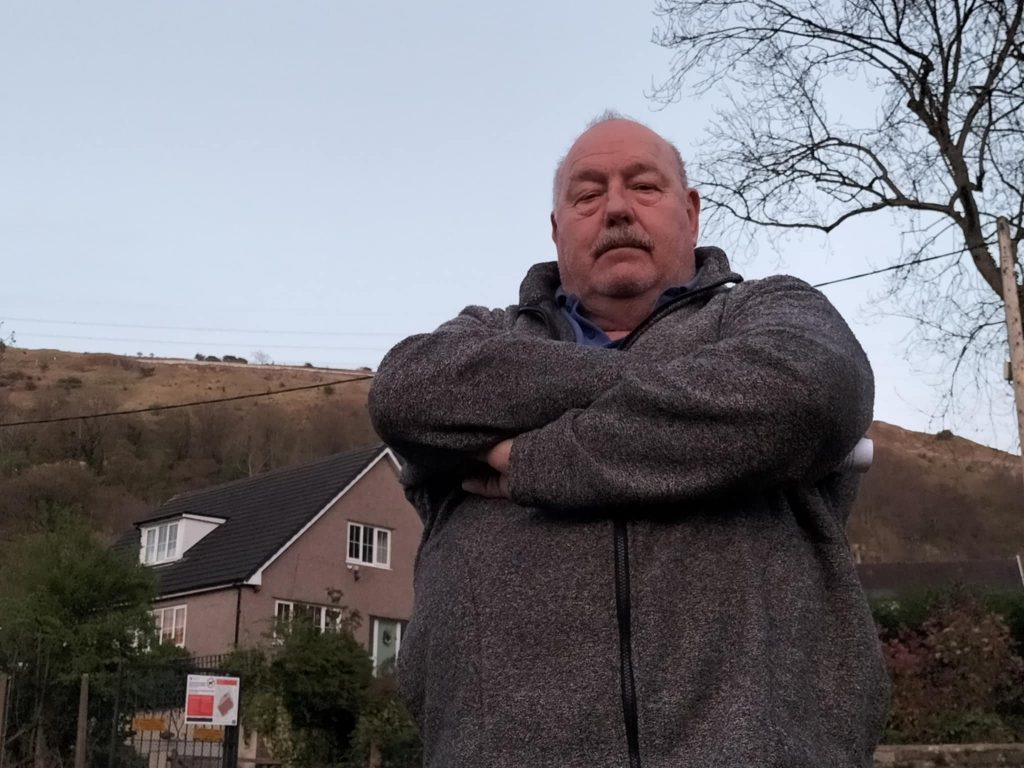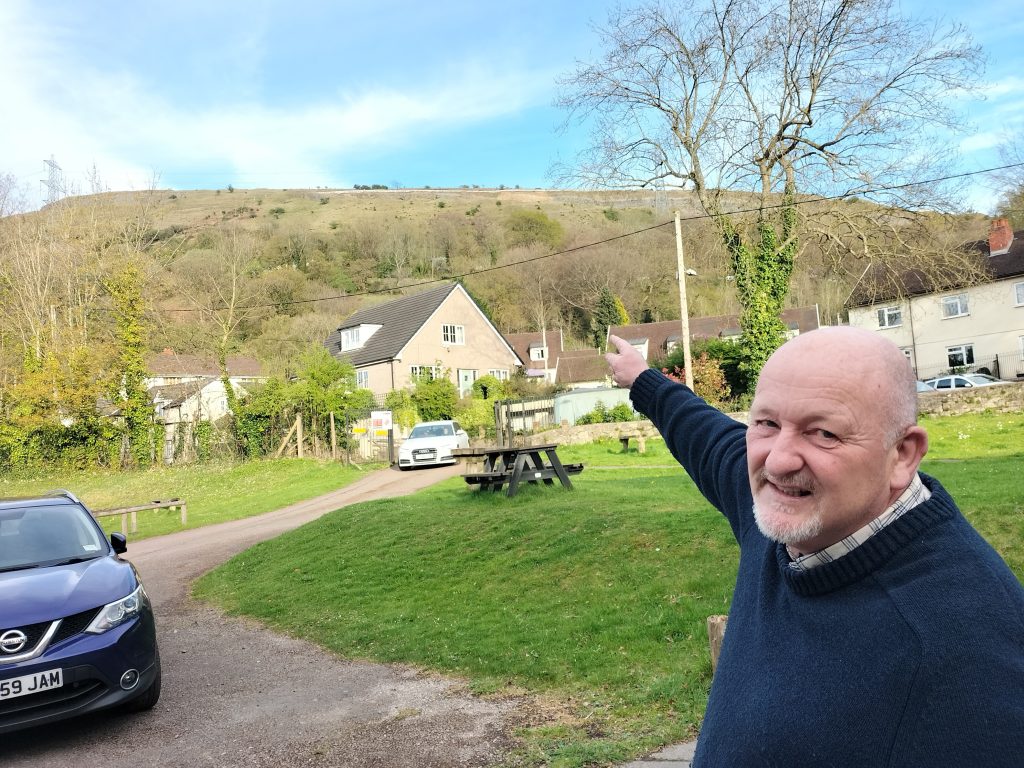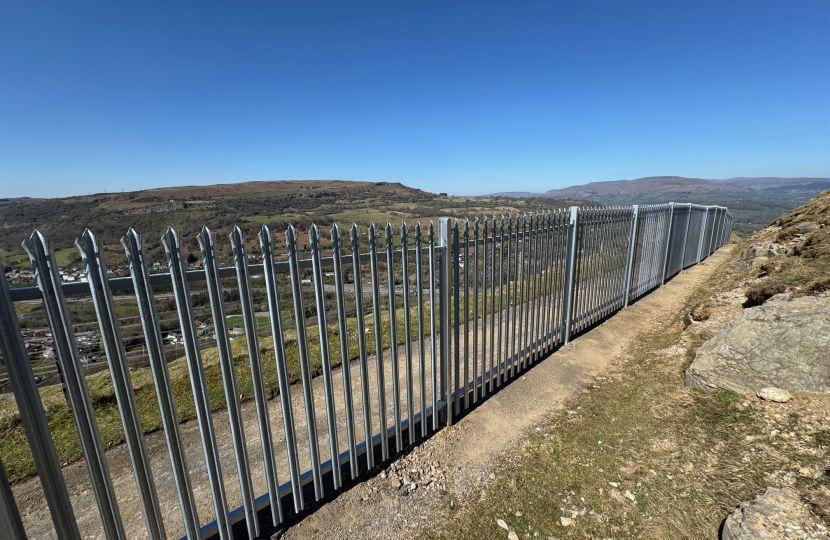A GIANT 2.1 metre tall steel fence that has been put across the side of mountain has been dubbed the ‘Great Wall of Clydach’ by villagers.
The galvanized steel palisade fence runs for some 200 metres along the length of Pwll Du Road, that has been temporarily closed to traffic for five years, and across the face of Gilwern Mountain that overlooks Clydach.
The area is within the Bannau Brycheiniog, or Brecon Beacons, National Park and close to the boundary of the internationally recognised UNESCO Blaenavon World Heritage site and from the ground appears as a solid structure or wall.
Residents, who confronted councillors and officials at an angry meeting in Clydach Village Hall on Wednesday evening, demanded it be taken down – despite the council’s insistence access to the road must be prevented due to fears it could collapse at any moment.

Top council bosses however did apologise for how the fence was put up over three days last week without warning and failures to keep promises the community would be kept updated on the future of the road.

They agreed the fence could potentially be reduce in height and painted a darker colour such as green to reduce the impact though it was also highlighted galvanized steel isn’t suitable for painting.
The council has said it will aim to mitigate the impact “as soon as practicable” and when it understands what local people want.
Most present at the meeting raised their hands when Llanelly Hill independent councillor Simon Howarth, who organised the meeting for local people to suggest alternatives, asked how many wanted it removed.
It was also revealed the fence has cost £40,000 to buy and install. Though it is intended as a temporary measure for nine months the council will consider pulling it down earlier.
Monmouthshire County Council’s neighbourhood manager Carl Touhig, who is responsible for highways, told the meeting previous efforts to keep vehicles off the road including gates and boulders had failed as they had been damaged or removed.
A rockfall in 2023 had prompted the council to commission a further report which has suggested the road should be closed to people, as well as vehicles, and outlined a number of options including new footpaths over the top of the mountain, and below the existing road, and rebuilding the road but moving the carriageway further back into the mountain.
Mr Touhig said it decided on the fence as a temporary measure and, in response to questions from the audience, said blocking the road at either side wasn’t sufficient as the open countryside meant people would still have access from above and below.
Rockfall has meant the carriageway is now almost at the cliff edge and Mr Touhig said: “A rockfall could take the whole road out.
“If someone was on that road and I know I’ve not made it safe I could be prosecuted for corporate manslaughter, and someone losing their live would be far worse than a prison sentence.”
He said motorcyclists have still been using the road and locals claimed since the fence was put up people have been using it to abseil down the rockface of the old quarry.

Former county councillor Martin Thomas called the fence “disgusting” and said he feared glare from the metal would cause an accident on the recently competed A465 beneath it.
He said: “What about the visual impact? It could cause the first fatality on the Heas of the Valleys road with people looking up at the glare, that is how bad it is.”
Farmer Wayne Elliot, who was involved in court action that ruled the road was a highway the council was responsible for, said the council had previously suggested putting the road further back, by cutting into the mountain.

One resident, who said his autistic daughter, had to turn back when her regular walking route was blocked by the fence and hadn’t left the house since, said: “You don’t understand if you think that’s okay to put that fence up there.”
He added: “You could shift the road back, the farmers would help do it, they’d get it done in a week and it would cost you a lot less.”
Mr Touhig said the cost estimate for rebuilding the road further into the mountain is more than £1m and would involve heavy machinery on unstable ground. He said: “You can’t have farmers going up there to build a road we would adopt. That is not going to happen.”
The highways chief also said planning permission wasn’t required for the fence, but the national park had been informed, with some residents complaining they are subject to the park’s strict planning requirements. Others asked if the impact on a breeding pair of peregrine falcons at the quarry had been considered and said the fence was impacting mental health and house prices.
Cllr Howarth, and Monmouthshire council’s Labour leader Mary Ann Brocklesby, who also represents the ward, said they hadn’t been informed before hand the fence was going up. Former council leader, and now Conservative Senedd Member for Monmouth, Peter Fox, said spending £40,000 would require political sign off at some stage.
Mr Fox said before the meeting he was “surprised” when the fence was brought to his attention and he could understand why it was considered an “eyesore”.

Senior council officer Debra Hill-Howells agreed at the meeting the council needed to get better at communicating as a highways authority and managing its relationship with the local community, the council will work with the community on mitigating its impact and to providing a permanent solution.
A further public meeting will be held on May 14.
Following the meeting Mr Elliot, whose farm is below the fence, said he isn’t convinced the road is dangerous. He said: “I used to use it all the time. I’m not worried about it collapsing it’s been there donkey’s years. We’ve been here 30 years and I’ve used it without any issue at all.”














